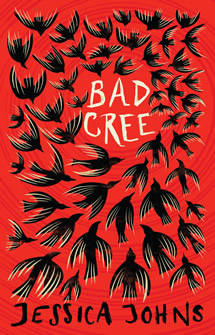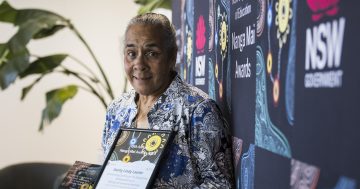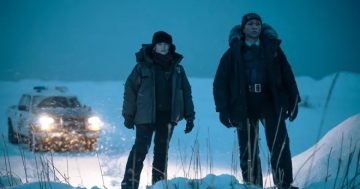Reviewed by Robert Goodman.
By Jessica Johns, Scribe, $29.99.
 Jessica Johns claims that she wrote her horror-inspired novel Bad Cree ‘as a form of revenge’. The revenge was against what could be described as the mainstream writing establishment, or from Johns’ point of view, the white colonialist establishment. That establishment held it is against the rules to write about dreams in fiction, and to do so would lose your audience. But as Johns points out, dreams are a quintessential part of Indigenous culture, and to deny this would be to deny their power and importance. And so she set out to write a book about her own culture in which dreams play a central role.
Jessica Johns claims that she wrote her horror-inspired novel Bad Cree ‘as a form of revenge’. The revenge was against what could be described as the mainstream writing establishment, or from Johns’ point of view, the white colonialist establishment. That establishment held it is against the rules to write about dreams in fiction, and to do so would lose your audience. But as Johns points out, dreams are a quintessential part of Indigenous culture, and to deny this would be to deny their power and importance. And so she set out to write a book about her own culture in which dreams play a central role.
This approach reflects observations Mykaela Saunders makes in the introduction to This All Come Back Now, her recently released collection of speculative fiction stories by Australian Indigenous authors:
Spec fic, as a Western genre, employs devices that our cultural stories have dealt in for millennia – the difference is, to us these stories aren’t always parsed out into fiction or fantasy, as they are just ways we experience life.
In Bad Cree the power of dreams is just part of the way the characters ‘experience life’.
When Bad Cree opens, Mackenzie wakes from an incredibly vivid dream with the head of a crow in her hands. While the head disappears, a scratch from the beak remains on her palm, along with a disturbing vision of her dead sister Sabrina being swarmed by crows. The dream serves to remind Mackenzie how she has run away from her problems, literally.
She fled to Vancouver, hundreds of miles from her Cree people, following the death of her kokum (grandmother), and did not return for Sabrina’s funeral a couple of years later. But the dreams become increasingly vivid and start to impinge on her waking world, forcing her to return home. Once there, Mackenzie needs to come to terms with the past and reconnect with her family while dealing with the forces that are tormenting her.
Mackenzie returns to an area that has been plundered for its resources. The oil companies came years before, exploited the people and the environment and left them worse off than they had been before. When Mackenzie returns, she cannot help but see a community that has been left behind:
Buildings that had opened up when I was a teenager for oilfield offices are now gated, closed up and dark … Rusted trucks and cars without wheels sit on front lawns.
Later, she considers the legacy of the industry:
I think about the toxic environment in the oil patch, the high depression rate among people based in camps for weeks and months on end, working every day. The way the industry changes men into worse men. The spike in missing Indigenous women, girls, and Two Spirit people with the rise of the industry.
‘We don’t know all the damage that was done to the land when people started extracting from it,’ Auntie Doreen continues.
The evil that Mackenzie and her family face is a creature of Cree lore that feeds on greed and sorrow, and it has homed in on Mackenzie’s guilt. But it is an evil that has been given power by the destruction of the environment and community; a spirit that persists even after the industry has moved on:
‘Greed lured them here, like bears to spawning fish. Or maybe they were turned here, created and set loose. Just like those damn pipelines, built underneath our feet and then abandoned.’
This is a thoroughly modern spirit. Appearing not only in Mackenzie’s dreams but also in her waking world, including sending her threatening text messages.
‘Auntie, how could Sabrina message me? That can’t be real.’
She scoffs into the phone. ‘Our ancestors and spirits have been speaking to us in a million different ways for thousands of years. You think they would have a hard time figuring out texting?’
Bad Cree is a creepily effective horror story. Johns makes the most of strange happenings, potentially deadly dreams, jump scares and evil spirits. This is a book that dares readers to turn off the light, consider not walking alone and possibly even turn off their phones.
But Bad Cree is ultimately about the power of family and the deep well of knowledge within the Cree community. Mackenzie reflects on the wisdom and strength of her kokum, and comes to recognise the importance of all of the women in her life:
Mom cooks us dinner while the aunties help us pack our bags. I’m reminded of how important our aunties are to our survival … They pre-prepared meals, coordinated where everyone would sleep, made sure we had enough blankets and pillows. Uncles followed orders, kids made things harder on everyone, but aunties carried the magic that made it all come together.
Bad Cree is part of a growing wave of Indigenous speculative fiction, including horror. In North America this includes writers like Eden Robinson (the Trickster trilogy), Rebecca Roanhorse (Trail of Lightning and Storm of Locusts) and Pulitzer Prize-winner Louise Erdrich (Future Home of the Living God). This All Come Back Now showcased a range of speculative fiction by Australian First Nations authors, but a spiritual element is central to much of modern Australian Indigenous fiction such as Nardi Simpson’s Song of the Crocodile or Alexis Wright’s award-winning Carpentaria.
As with all the authors mentioned above, its cultural roots make Bad Cree much more than a horror story. The narrative is Johns’ way of illuminating and celebrating her community: its tribulations, its connections and most of all its resilience. Even the name of the book itself comes into play in Mackenzie’s conversations with her mother – the question of whether she is indeed a ‘bad’ Cree and whether that is even a useful way to think.
In the end, Johns has her revenge. She has delivered a sometimes chilling, page-turning narrative in which dreaming and the power of dreams is central. But Bad Cree is also a stake in the ground for the power of a community that continues to survive while dealing with the ongoing destructive impacts of colonisation and environmental exploitation.
This review first appeared in Newtown Review of Books.
Over 850 more book reviews can be found on Pile by the Bed.











